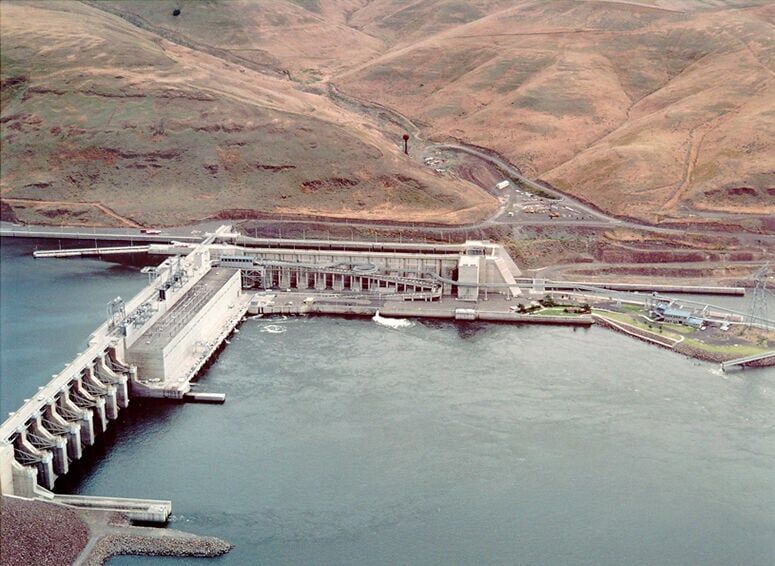Report: Breaching Snake River dams would put thousands of farmers at risk
Published 1:00 pm Wednesday, August 16, 2023

- Little Goose Dam near Starbuck, Wash., one of four dams on the Lower Snake River.
SALEM — The livelihoods of thousands of farmers would be put at risk if the four Lower Snake River dams are breached, a new study says.
The study from the Pacific Northwest Waterways Association examined the economic, environmental and social justice impacts associated with breaching the dams, long targeted by environmental groups and tribes seeking endangered salmon recovery.
Twelve counties — six in Washington, five in Idaho and one in Oregon — would be directly impacted by removal of the dams, according to the report, issued Sunday, Aug. 13.
About 7,644 farms in the affected area generate approximately $2 billion in annual sales, according to the report.
“Most would have a very high likelihood for bankruptcy unless the federal government stepped in and significantly increased subsidies,” said Heather Stebbings, policy adviser for the association.
The majority of the farms that are small to medium-sized would be most at risk, said Stebbings and Leslie Druffel, co-chair of the association’s Inland Ports and Navigation Group.
If the dams were removed, barging wheat to downstream ports for export would be impossible. Using trucks or railroads would significantly drive up the cost of transportation.
Moving commodities from barge to truck or rail would increase the cost of wheat per bushel by at least 8%, the report states.
Because the market price of wheat is determined by such global factors as international demand, global supplies and currency rates, increasing wholesale prices for commodities to cover the added cost of transportation “is not an option and has a high probability of bankrupting over 7,600 farms unless U.S. farm subsidies to the tri-state region increased by $55 million a year or $1.65 billion over 30 years,” according to the analysis.
Other concerns range from the inability to irrigate crops to the logistics of shipping through port terminals, mitigation costs for wastewater outfalls and new investments in water intakes, filtration and pumping and transmission systems.
“The loss of irrigation would, of course, devastate the farms that depend on water from the Ice Harbor pool, and the 8% increase in transportation costs is too much for dryland farms, especially when you are paying the cost of freight,” Stebbings said.
Federal mediation in the long-running litigation tied to the dams is slated to end Aug. 31. The association provided the study to the mediation teams and federal government to disseminate to all parties in the mediation, Stebbings said.
IPNG is a party to the mediation.
The Capital Press has sought a response to the study from Earthjustice, the law firm leading a coalition of environmental and fishing groups in a federal lawsuit over dams’ operations plan.
Much of the information about impacts on transportation, climate and the economy has been shared all along, but agricultural stakeholders wanted to take a “deeper dive” into the impacted communities, Stebbings said. The report uses data from the White House Climate and Economic Justice Screening Tool.
“We look at this as another layer of information to be included in the discussion, especially when we look at some of the demographics we see in these counties, where we see higher poverty rates, lower income, higher unemployment,” she said. “We really believe these folks need to be considered in the decision making on this.”
The communities in the study area are nearly 10 times more dependent on agriculture than the national average. The region is already suffering from higher rates of unemployment, poverty, energy cost burdens, risk of natural hazards such as fire, asthma and travel barriers, according to the report.
Farm bankruptcy would result in employment and wage losses that would lead to less tax revenue and services, including schools, clean drinking water, safe roads and emergency services.
Moving from barging on the river to truck and rail transportation would require 5 million more gallons of diesel each year, and increase carbon dioxide and other harmful emissions by 1.2 million tons, the equivalent of 181,000 passenger cars or adding one new large coal-fired power plant every two to three years, according to the association.
Breaching and related mitigation costs are estimated to cost between $10.5 billion and $65.7 billion.
The highway and rail network would need a short-term $1.3 billion capital investment to handle 4.2 million tons of annual shipments to and from the region.
“The crucial jobs at risk of being lost include hard-working haulers, planters, pruners and harvesters — all essential for providing agricultural produce to consumers,” the report states. “They are already in short supply with first-generation Americans, seasonal farm workers, and disadvantaged workers.”
The final decision on breaching the dams remains with Congress, Stebbings said.
“We do not believe Congress has any desire to consider dam breaching, currently,” she said.
Vilsack on Snake River dams: Ag ‘well-represented’ in mediation
Lock and dam system benefits Pacific Northwest, advocate says
Conservation, fishing groups intend to sue to remove Snake River dams
Industry: Wheat export costs would jump without Snake River dams, barges
White House says it’s neutral on Snake River dam mediation
Ag stakeholders: Mediation skewed toward breaching dams
Efforts aim at improving salmon survival at Snake River dams
Amid a battle over Snake River dams, a look at how the salmon are doing
Idaho ag industry adds voice with letter to Vilsack on Snake River dams
Ag advocates worry their message has been lost during Snake River dam mediation
NW ag industry to Vilsack: Step in on Snake River dam mediation
Northwest lawmakers introduce bill to protect Snake River dams
Final report: Dam breaching ‘centerpiece’ of restoring Snake River fish populations
Q&A: Simpson continues to push lower Snake River dam plan
Ag stakeholders consider next steps on Snake River dams
Inslee-Murray report: Snake River dam breaching not feasible now




